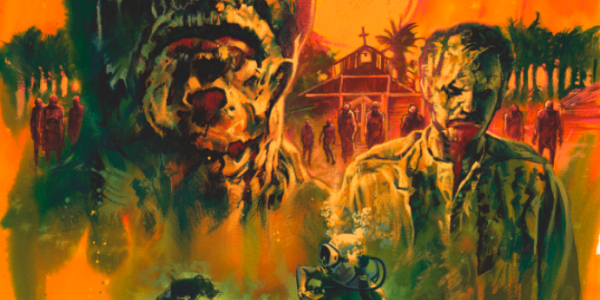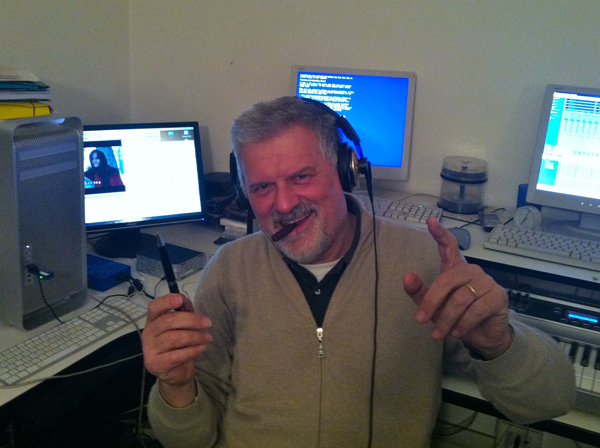Fabio Frizzi (born July 2, 1951) is an Italian musician and composer.
Born in Bologna, Emilia-Romagna, he is best known for his film scores. A frequent collaborator with famous horror director Lucio Fulci, his scores have become some of the most widely known in the genre.
http://en.wikipedia.org/wiki/Fabio_Frizzi
Aided by Giorgio Cascio and Goblin’s keyboard maestro Maurizio
Guarini, Frizzi conjures up a hypnotic, pulsing synth showcase, chiming
xylophones merging with layers of bubbling, wailing synths. Sequence 6 –
also known as ‘Eyeball’ on earlier releases – takes things even
further, rattling percussion and shrieking guitar driving the music
towards the film’s most famous gore sequence, as unlucky Olga Karlatos
gets a foot-long shard of timber driven into her peepers.
Elsewhere Frizzi focuses on evoking the claustrophobic atmosphere of
the jungle; sequences 3, 4 and 7 are heavy on the tribal percussion and
moody ambient sounds. But it’s the title track (Sequence 8 on the Death
Waltz release) that provides Zombi 2 with its signature piece. A dull,
insistent thud that sounds like a primitive drum machine but is in fact
nothing more than Frizzi tapping a mike carries a strangely beautiful
melody that is both haunting and melancholic. Using a mellatron –
essentially an early, analogue sampling device – Frizzi creates a
melodic bed of disembodied voices, producing one of the key pieces of
Italian horror film music.
Dan Auty
http://www.eatsleeplivefilm.com/videodrone-4-zombi-2the-beyond/
Fabio Frizzi and Giorgo Cascio make much of pounding, heart-beat
drums and woodwind, linking the narrative to its Caribbean location like
the backing tape in a dreadful theme bar where waiters serve drinks in
hollowed out coconuts and pineapples, the steady rhythm sticking around
long enough to be thick and oppressive, like a jungle march, the air
thick with mosquitoes and the sickly tang of decaying plantlife.
Whenever the keyboard or drums appear to beat out a tacky calypso,
the room starts to spin with oncoming delirium, undercut by a pining
whalesong of pleading or melancholy, perhaps while Fulci pans over still
corpses or our heroes huddled together for the night while shapes
gather in the darkness under the canopy.
Eighties horror is generally parodied for its over-indulgence of
menacing synths, and there’s no shortage of tension building mellotron
in Frizzi and Cascio’s score, but there’s an off-ripe sickliness to it,
and that trademarked keening howl of dead voices. While Romero’s world
was one of sterile urbanity and silence, prowled by desiccated husks,
Fulci’s Zombi 2 has an off-ripe, diseased look, a constant buzz
of flies and splash of water against the dock, a warmer, faded colour
palate that echoes its fever dream setting.
A fantastically off-kilter listen, testament to the composers, and of
course Lucio Fulci himself, to have created something equal parts
derivative and unique, and implacable and fitting. And of course to the
grandly titled Death Waltz Recording Company
for a treatment that oozes syrupy pus of love and respect, that even
the most enthusiastic zombie fan will discover a whole new appreciation
for one of the subgenre’s most beloved, and idiosyncratic, video
nasties.
James Hoare
http://www.scifinow.co.uk/stuff/24558/zombi-2-zombie-flesh-eaters-vinyl-soundtrack-review/
In 1979 Fabio Frizzi offered a more subtle approach to the Italo-horror
soundtrack, one which deftly combined the minimalist structures of new
music composers like Philip Glass and Steve Reich with experimental
rock, funk and early electronica. While Goblin’s Bacchanalian
soundtracks are a fitting accompaniment to the garish colors and extreme
art direction of Argento, Frizzi’s scores bear a more oblique
relationship to the violence and gore they accompany. Zombie 2 was director Lucio Fulci’s attempt to cash in on the success of George Romero’s Dawn of the Dead, released as Zombie
in Italy, and though far from being a worthy successor, its Grand
Guignol horrors set a new standard for movie gore. Boasting an
unforgettable underwater battle between a zombie and a shark, the film
succeeds by sheer audacity and brazen energy.
Frizzi’s score is no less brazen or energetic, but transcends its
filmic context—and in some respects the Italian horror film score
tradition itself—by offering a richly arranged and measured composition
without sacrificing the film’s violent urgency. By 1979 the synthesizer
was beginning to emerge in popular music, most notably in the early
synth-pop of British artists like Gary Numan, The Human League, and OMD,
where it became synonymous with urban unease and future shock.
Frizzi’s score is clearly influenced by the synthesizer’s new austerity
measures, as well as drawing from earlier analogue techniques developed
by German synthesized space rock, or kosmische music and English prog
alike. The most distinctive of the various sounds-of-futures-past
dredged up by Frizzi is that of the mellotron, an early electronic
keyboard that actually plays pre-recorded tape reels of choral and
orchestral sounds. While it was most famously used to grandiose effect
in King Crimson’s In the Court of the Crimson King, in Frizzi’s
hands the mellotron’s oddly compressed choral effects sound more like a
choir of the undead muffled by graveyard soil.
Frizzi’s melding of the futuristic with the moribund in his use of
electronics is matched by his peculiar melodic lines, which often move
uncannily between the lively and the funereal. While the Zombie 2 soundtrack
often bears only an oblique reference to the violent and frenetic story
line, this merging of the sounds of life and death provides a
disturbingly effective aural equivalent to the undead creatures
on-screen. Frizzi’s soundtrack sounds both shockingly new in its use of
stark synthesizer tones, and uncomfortably old in its use of tonal
distortion and decay. Freud famously defined “the uncanny” as the sense
of unease we feel when encountering something that seems alive when we
know it should be dead. It is an elusive quality that Frizzi manages to
evoke melodically and sonically with seeming effortlessness.
Jed Mayer
http://blogs.indiewire.com/pressplay/screaming-hides-the-sound-the-resurrection-of-fabio-frizzi
Saturday 2 November 2013
Subscribe to:
Post Comments (Atom)





No comments:
Post a Comment